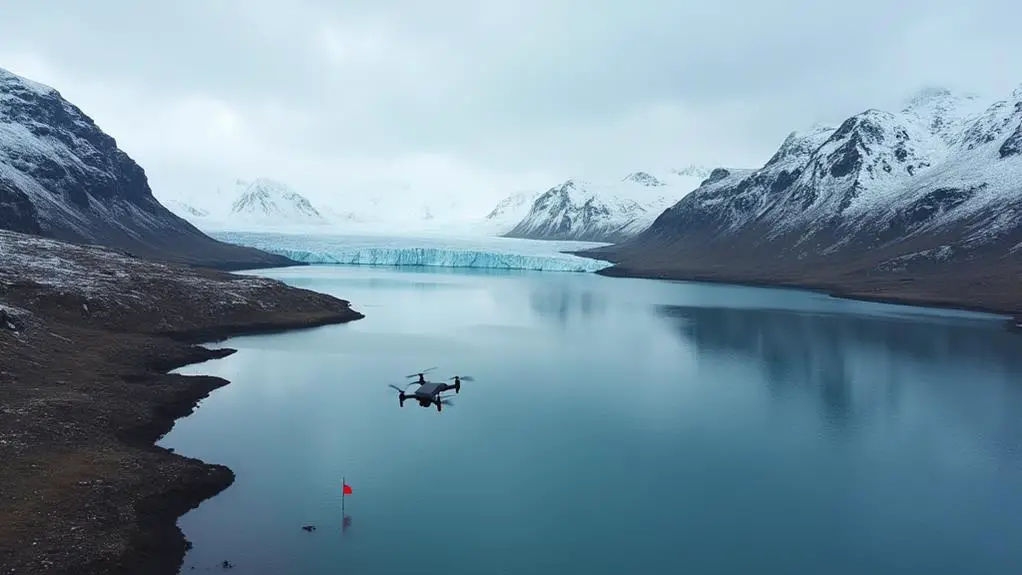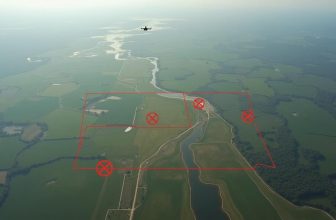
Imagine you're a photographer planning to capture Iceland's breathtaking landscapes with your drone – but you're not sure if you're allowed to fly over that stunning waterfall. As it turns out, Iceland has specific drone laws in place to protect its unique environment and ensure public safety. If you're planning to fly a drone over 250 grams or use it for commercial purposes, you'll need to register it – but that's just the beginning. To avoid costly fines or even imprisonment, you'll need to know the ins and outs of Iceland's drone regulations.
Contents [hide]
Key Takeaways
- Drones over 250g or used commercially must be registered with the Icelandic Civil Aviation Administration.
- Maximum allowed flight altitude is 120 meters above ground level, with exceptions for mountain flying.
- Drone operation is prohibited within airport boundaries, military zones, and other restricted areas marked on aeronautical charts.
- Drone operators must maintain a safe distance from air traffic and follow all regulations to avoid fines and penalties.
- Fines for non-compliance with drone laws range from ISK 50,000 to ISK 500,000, with severe cases resulting in imprisonment.
Drone Registration Requirements
When you acquire a drone, you'll need to register it with the relevant authorities if it meets certain weight and usage criteria.
In Iceland, drones weighing over 250 grams or those that are used for commercial purposes must be registered with the Icelandic Civil Aviation Administration.
This requirement also applies to drones that are equipped with cameras or other data collection devices.
If you're a foreign owner of a drone, you'll also need to register it with the Icelandic authorities.
You'll need to provide documentation that proves your ownership and identity.
Additionally, you may need to obtain drone insurance, which covers damage to third-party property or injuries to people.
Registration requirements typically include providing information about the drone's make, model, and serial number, as well as your contact information and proof of ownership.
You may also need to pay a registration fee.
Drone insurance is mandatory for commercial drone operations, but it's also recommended for recreational drone owners to ensure they're covered in case of an accident.
Permitted Flight Altitudes
Registering your drone is just the first step in ensuring you're compliant with Icelandic drone regulations. Next, you need to understand the permitted flight altitudes to avoid any issues during your drone operations.
When flying in Iceland, you should be aware of the maximum allowed altitude, which is 120 meters (394 feet) above ground level. For mountain flying, you can fly higher than this limit if you're flying at or below the height of the highest obstacle within a 50-meter (164-foot) radius of your drone. However, you must still maintain a safe distance from air traffic and follow all other regulations.
| Type of Flight | Maximum Altitude | Special Considerations |
|---|---|---|
| Standard Flight | 120 meters (394 feet) | Below 120 meters above ground level |
| Mountain Flying | At or below highest obstacle within 50 meters | Maintain safe distance from air traffic |
| Flight near Coastal Limits | 120 meters (394 feet) | Follow all standard flight regulations |
Restricted Airspaces
Iceland's airspace restrictions are a key aspect of safe and responsible drone operations.
When you're planning to fly your drone in Iceland, it's essential to know the restricted airspaces to avoid any potential risks or penalties.
You're not allowed to fly your drone within airport boundaries, including takeoff and landing zones, as well as areas directly beneath flight paths.
This restriction applies to all airports in Iceland, including Keflavik International Airport and Reykjavik Airport.
Additionally, you must respect military zones, which are clearly marked on aeronautical charts and maps.
These areas are restricted due to national security concerns, and any unauthorized drone activity can lead to severe consequences.
It's crucial to stay informed about the latest airspace restrictions and updates before each flight.
You can find this information on the official website of the Icelandic Transport Authority or through mobile apps that provide real-time airspace data.
Always prioritize safe and responsible drone operations by adhering to these restrictions.
Operating Drone Safely
Operating your drone safely requires careful planning and adherence to specific guidelines. When flying in Iceland, you must consider the country's unique environment and cultural heritage. It's essential to show cultural sensitivity and respect for historical sites, national parks, and private properties.
To ensure safe and responsible drone operations, you should:
| Pre-Flight Checks | In-Flight Precautions | Post-Flight Procedures |
|---|---|---|
| Check the weather forecast | Maintain a safe distance from people and animals | Turn off your drone's motor and propellers |
| Ensure your drone is in good working condition | Be aware of your surroundings and potential obstacles | Store your drone in a secure location |
| Familiarize yourself with local regulations and airspace restrictions | Keep your drone in sight at all times | Review your flight data and footage |
Consider investing in drone insurance to protect yourself and others in case of accidents or unforeseen events. By following these guidelines and being mindful of your surroundings, you can minimize risks and ensure a safe and enjoyable drone flying experience in Iceland. Always prioritize caution and respect for the environment and local communities.
Fines and Penalties
While taking the necessary precautions to ensure a safe and responsible drone flying experience in Iceland, it's equally important to understand the consequences of non-compliance.
If you fail to follow the drone laws and regulations in Iceland, you may face serious legal consequences and financial implications.
In Iceland, the Icelandic Transport Authority (ICETRA) is responsible for enforcing drone regulations.
If you're found violating these regulations, you may be subject to fines and penalties. The fines can range from ISK 50,000 to ISK 500,000 (approximately EUR 350 to EUR 3,500).
In severe cases, you may also face imprisonment for up to 6 months.
Additionally, if your drone causes damage to property or injures someone, you may be liable for the damages.
This can result in significant financial implications, including compensation for damages and potential lawsuits.
It's crucial to understand that these consequences aren't limited to the drone operator but may also extend to the drone's owner.
Frequently Asked Questions
Can Tourists Bring Personal Drones Into Iceland?
Before traveling to Iceland, you'll need to research travel regulations and customs restrictions on personal drones. You can bring them, but must comply with Icelandic laws, declare them at customs, and follow specific guidelines during your stay.
Are Underwater Drones Subject to the Same Laws?
You might think underwater drones are exempt from regulations, but they're actually subject to the same laws as aerial drones, particularly in Iceland, where ocean exploration and marine research require careful planning and permits.
Do Drone Laws Apply to Model Airplanes in Iceland?
You should check if model airplanes in Iceland are subject to specific model regulations or fall under broader aviation standards, as these may differ from drone laws and dictate the rules for model aircraft operation.
Can I Operate a Drone in Iceland's National Parks?
As you soar a drone above Iceland's breathtaking landscapes, exploring national parks like Vatnajökull's glaciers or Þingvellir's rift valleys, you'll need to navigate park restrictions, obtaining drone permits in advance, to ensure compliant, responsible operation.
Do I Need Insurance for My Drone in Iceland?
When operating a drone abroad, you'll likely need insurance coverage. In Iceland specifically, you might want drone coverage with liability limits that protect you financially in case of accidents or damages to people or property.
Conclusion
As you prepare to capture Iceland's breathtaking landscapes, remember that compliance is key. The rugged beauty of the land can quickly turn into a harsh reality if you don't follow the rules. Like a double-edged sword, Iceland's drone laws can cut both ways – offering freedom to explore the skies or imposing penalties for reckless behavior. Ensure a smooth flight by registering, respecting altitudes, and avoiding restricted areas.






